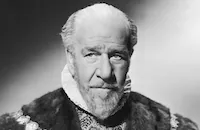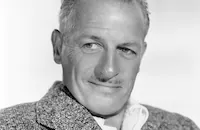The Richest Girl in the World

Brief Synopsis
Cast & Crew
William A. Seiter
Miriam Hopkins
Joel Mccrea
Fay Wray
Henry Stephenson
Reginald Denny
Film Details
Technical Specs

Synopsis
To avoid publicity upon her return to the United States, Dorothy Hunter, the "richest girl in the world" whom the "world" has never seen, uses her secretary, Sylvia Lockwood, to impersonate her. Just before she is to announce her upcoming marriage, Dorothy's fiancé Donald breaks their engagement, explaining that he has fallen in love with someone else. Devastated by Donald's contention that no man could ever love her for herself, Dorothy enlists Sylvia to pose as her at her engagement party. There, while pretending to be Sylvia, Dorothy meets handsome Tony Travers and plays a game of pool with him. Tony, believing Dorothy to be the secretary, invites her to a canoe ride, but winds up taking Sylvia instead. Furious, Dorothy, with Sylvia's husband Phillip in tow, pursues Tony and Sylvia in a speedboat and causes their canoe to capsize. Although Tony insists that his interest in Sylvia is strictly polite, Dorothy insinuates that if the opportunity to marry the heiress presented itself, he would take it. While maintaining that he prefers Dorothy, Tony accepts the false secretary's challenge to woo "the heiress" and agrees to invest his modest savings in a speculative stock venture in order to finance his courtship. After two weeks of romancing, Dorothy, whose guardian, John Connors, believes that her "love tests" are unfair, advises Tony to propose to Sylvia during a scheduled Adirondack retreat. Buoyed by Dorothy's confidence in him, Tony goes to the mountain retreat as planned, unaware that Dorothy has arranged for them to spend the first evening alone. As Tony lies with his head in her lap in front of a cozy fire, Dorothy falls deeper in love with him, but is dismayed when, after confessing his love for her, he admits that Sylvia "wouldn't have him anyway." In spite of John's continued protests, Dorothy refuses to accept Tony's love until she has proven to herself that she, as a secretary, is his first choice. To that end, she pushes Tony to propose to Sylvia the next night, and as instructed by Dorothy, Sylvia accepts. Later, however, Tony sees Phillip sneak into Sylvia's bedroom, and the next morning, he slugs Phillip at the breakfast table and denounces Sylvia. As a last test of love, Dorothy explains to Tony that she had switched rooms with Sylvia. When Tony then carries her off in a display of masculine authority and marries her, Dorothy finally believes in his love. Although Dorothy insists on continuing her impersonation during her ocean cruise honeymoon, John surreptitiously orders the newly married couple to be given luxurious accomodations, delighting Tony with the ship's remarkable second-class service.

Director

William A. Seiter
Cast

Miriam Hopkins

Joel Mccrea

Fay Wray

Henry Stephenson

Reginald Denny
Beryl Mercer

George Meeker
Wade Boteler

Herbert Bunston
Burr Mcintosh
Edgar Norton
Fred Howard
Crew
Rex Bailey
Pandro S. Berman
George Crone
Leona D'ambry
Jerry Hutchinson
Charles Kirk
Norman Krasna
Nick Musuraca
Van Nest Polglase
Max Steiner
John E. Tribby
Glenn Tryon

Film Details
Technical Specs

Award Nominations
Best Writing, Screenplay
Articles
The Richest Girl in the World
The story and screenplay is by Norman Krasna, then in his early twenties and only six credits into what would be an illustrious career. He scored his first Oscar® nomination for this picture (for Best Original Story), and while he lost to Arthur Caesar for Manhattan Melodrama (1934), Krasna would be nominated three more times, finally winning for Princess O'Rourke (1943), which he also directed. Among his other writing credits: Fury (1936), Bachelor Mother (1939), Mr. and Mrs. Smith (1941), The Devil and Miss Jones (1941), White Christmas (1954), Indiscreet (1958) and Let's Make Love (1960). In writing this story, Krasna was undoubtedly inspired by the real-life "richest girl in the world" -- socialite and Woolworth heiress Barbara Hutton, who was about 21 at the time.
In an interview years later, Krasna spoke about his penchant for writing social comedy: "I always get in my social comment -- but limited to what the subject needs. I certainly don't go on the wrong side. I will not write that if you have a lot of money you're a better person.... For instance, The Richest Girl in the World. If I use as a plot that the richest girl in the world poses as her own secretary in order to get some privacy, how clever! The only thing is, eventually she ought to fall in love and get married. I like that idea. So what I do is -- the fella falls in love with the richest girl in the world, only he thinks she's the secretary. There you are -- she's pure in heart. To his credit. That's everybody's daydream. I give you a reward. I make you laugh. But I always show you what the right side is: your emotions go along with the underdog."
RKO paid Krasna $4000 for his story, with Ann Harding in mind to star. But in the end the studio borrowed Miriam Hopkins from Paramount and Fay Wray from 20th Century Pictures and teamed them with RKO's own contract player Joel McCrea. This would be McCrea's last film under the contract. He had grown unhappy with the RKO assignments and loanouts over the previous five years, and after this film he made a picture each at Paramount, Fox and MGM before signing with Samuel Goldwyn Productions. By that time Hopkins had signed there as well, and the duo teamed up for four more movies over the next three years, including These Three (1936).
Director William Seiter is an undeservedly neglected filmmaker whose best pictures, in the 1930s, were models of brisk efficiency and real charm. Usually they were comedies. Fay Wray later wrote of him, "Seiter was born understanding laughter." That's certainly a reason Variety raved about The Richest Girl in the World, calling it "a pip picture for Miriam Hopkins [in] the sort of role actresses dream about. Eighty minutes of unerring entertainment." The public agreed, turning the picture into a Depression-era hit.
The Richest Girl in the World was remade officially as Bride by Mistake (1944), starring Laraine Day and Alan Marshal, and unofficially (and more loosely) as The French Line (1953), starring Jane Russell and Gilbert Roland.
Producer: Pandro S. Berman
Director: William A. Seiter
Screenplay: Norman Krasna (screenplay and story); Leona D'Ambry (contributor to adaptation and continuity, uncredited); Glenn Tryon (contributor to comedy construction, uncredited); Jerry Hutchinson (contributor to continuity, uncredited)
Cinematography: Nick Musuraca
Art Direction: Charles Kirk, Van Nest Polglase
Film Editing: George Crone
Cast: Miriam Hopkins (Dorothy Hunter, aka Sylvia Lockwood), Joel McCrea (Anthony 'Tony' Travers), Fay Wray (Sylvia Lockwood, aka Dorothy Hunter), Henry Stephenson (Jonathan 'John' Connors), Reginald Denny (Phillip 'Phil' Lockwood), Beryl Mercer (Marie, Dorothy's Maid), George Meeker (Donald 'Don'), Wade Boteler (Jim 'Jimmy' Franey), Herbert Bunston (Dean Cavandish, Chief Trustee), Burr McIntosh (David Preston).
BW-76m. Closed Captioning.
by Jeremy Arnold
SOURCES:
Roy Kinnard and Tony Crnkovicj, The Films of Fay Wray
Patrick McGilligan, Backstory
Tony Thomas, Joel McCrea: Riding the High Country
Fay Wray, On the Other Hand

The Richest Girl in the World
Fay Wray (1907-2004)
She was born Vina Fay Wray, in Cardston, Alberta, Canada on September 15, 1907. Her family relocated to Arizona when she was still a toddler so her father could find employment. When her parents divorced, her mother sent her to Hollywood when Fay's eldest sister died in the influenza epidemic of 1918. The reasoning was that Southern California offered a healthier climate for the young, frail Wray.
She attended Hollywood High School, where she took some classes in drama. After she graduated, she applied to the Hal Roach studio and was given a six-month contract where she appeared in two-reel Westerns (25 minutes in length), and played opposite Stan Laurel in his pre-Oliver Hardy days.
She landed her first big role, as Mitzi Schrammell, in Erich von Stroheim's beautifully mounted silent The Wedding March (1928). It made Wray a star. She then starred in some excellent films: The Four Feathers (1929), the early Gary Cooper Western The Texan (1930), and one of Ronald Coleman's first starring roles The Unholy Garden (1931), all of which were big hits of the day.
For whatever reason, Wray soon found herself in a string of thrillers that made her one of the great screamers in Hollywood history. The titles say it all: Doctor X, The Most Dangerous Game (both 1932), Mystery of the Wax Museum, The Vampire Bat (both 1933) and, of course her most famous role, that of Ann Darrow, who tempts cinema's most famous ape in the unforgettable King Kong (also 1933).
Wray did prove herself quite capable in genre outside of the horror game, the best of which were Shanghai Madness with Spencer Tracy; The Bowery (both 1933), a tough pre-Hays Code drama opposite George Raft; and the brutal Viva Villa (1934), with Wallace Beery about the famed Mexican bandit. Yet curiously, the quality of her scripts began to tank, and she eventually found herself acting in such mediocre fare as Come Out of the Pantry (1935), and They Met in a Taxi (1936).
With her roles becoming increasingly routine, the last of which was the forgettable comedy Not a Ladies Man (1942), she decided to trade acting for domesticity and married Robert Riskin, who won two Best Screenplay Oscars® for the Frank Capra comedies It Happened One Night (1934) and Mr. Deeds Goes to Town (1936). When Riskin died in 1955, Wray found herself working to keep busy and support her three children. She landed supporting parts for films like The Cobweb (1955), Hell on Frisco Bay (1956) and Tammy and the Bachelor (1957). She also found work in television on such popular programs as Perry Mason and Wagon Train before she retired from acting all together in the mid-'60s.
To her credit, Wray did remain reasonably active after her retirement. She published her autobiography, On The Other Hand in 1989 and was attending many film festivals that honored her contribution to film, most notably in January 2003, when, at 95 years of age, she accepted in person her "Legend in Film" Award at the Palm Beach International Film Festival. Wray is survived by a son, Robert Riskin Jr.; two daughters, Susan and Victoria; and two grandchildren.
by Michael T. Toole
Fay Wray (1907-2004)
Quotes
Trivia
Notes
An April 1934 Hollywood Reporter news item announced that RKO outbid M-G-M for the rights to Norman Krasna's original screenplay, paying the writer $4,000. At that time, the picture was being considered as a vehicle for Ann Harding. According to a June 1934 Hollywood Reporter news item, John Norton was engaged by RKO to write the screenplay for the film. The exact nature of Norton's contribution to the production has not been determined. RKO borrowed Miriam Hopkins from Paramount and Fay Wray from Twentieth Century for this production. According to a Hollywood Reporter production chart, Charles Coleman and William Burress were in the cast, but their participation in the final film has not been confirmed. Some exteriors for the film were shot at Lake Arrowhead, CA, according to Daily Variety. Krasna was nominated for an Academy Award in the Best Story category, but lost to Arthur Caesar, who wrote Manhattan Melodrama. According to modern sources, producer Pandro Berman bought Krasna's story with his own money, then sold the idea to his RKO superiors. Modern sources contend that during this period, the twenty-two-year-old Krasna was being blackballed by M-G-M's Louis B. Mayer, and as a result of this blackballing, other studios were reluctant to hire him. RKO remade Krasna's story in 1944 under the title Bride By Mistake. That film was directed by Richard Wallace and starred Laraine Day and Alan Marshall.














